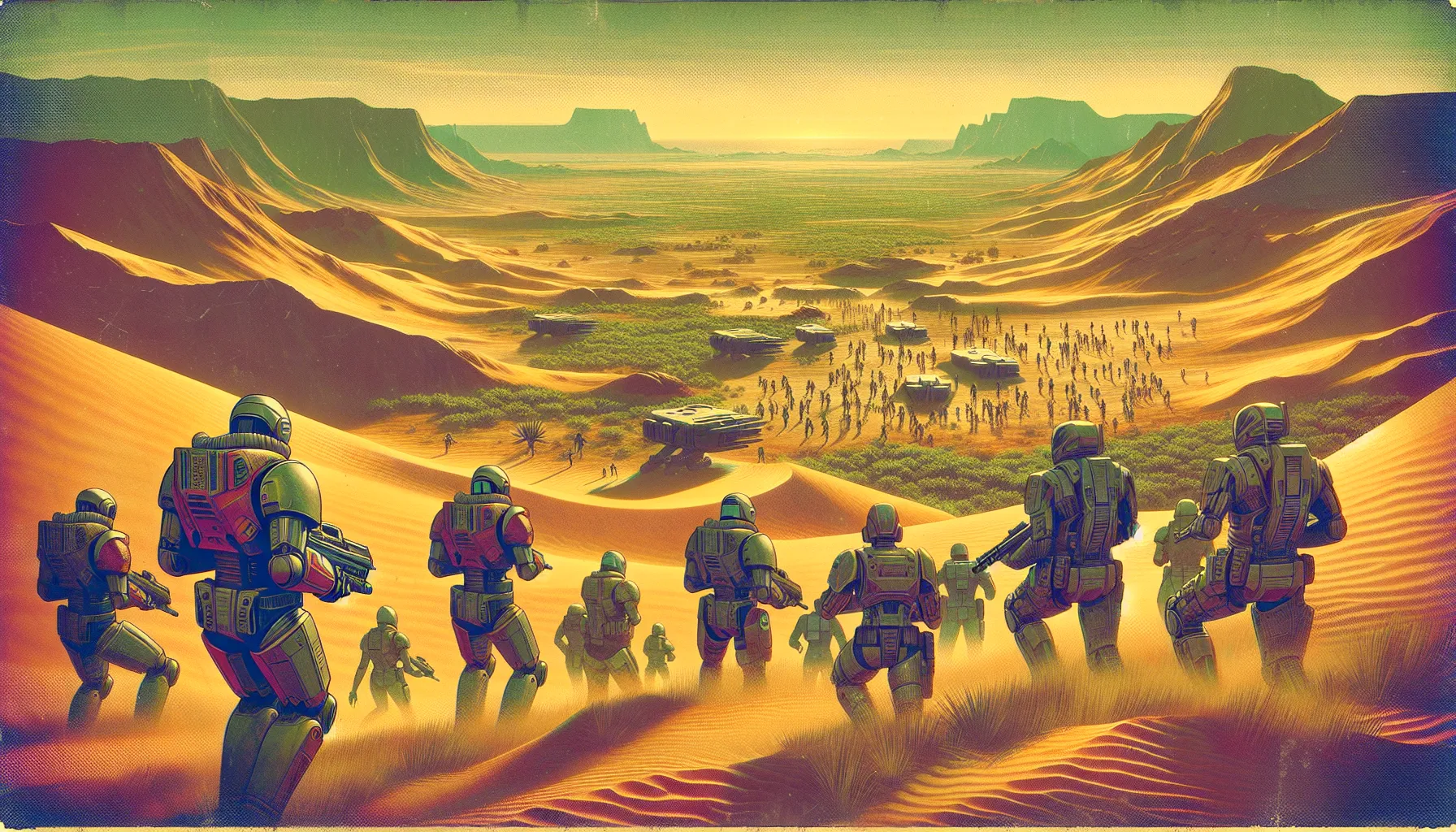If you’re diving into the vast open world of Dune: Awakening, one question likely on your mind is how many players you’ll share the experience with. The game’s promise of a massive, living desert teeming with adventure has sparked curiosity about its multiplayer dynamics. After all, knowing the server capacity can shape your expectations for collaboration, competition, and survival.
In a game where alliances and rivalries play a pivotal role, understanding the server size gives you a glimpse into the scale of interactions you’ll face. Whether you’re planning to dominate the spice trade or fend off sandworms with a crew, the number of players per server could determine just how intense your journey gets.
Overview Of Dune: Awakening
Dune: Awakening is an open-world survival MMO set on Arrakis, inspired by the Dune universe. You explore vast deserts, gather resources, and face challenges such as sandstorms and massive sandworms. The game combines survival elements with large-scale multiplayer interactions.
Customization plays a key role. You can tailor your character’s abilities, gear, and playstyle to adapt to the desert’s demands. These elements enhance your chances of thriving amidst unpredictable events and player-driven economies.
The game’s dynamic environment shifts based on player actions. You’ll encounter evolving landscapes, unlock hidden locations, and face periods of scarcity or abundance, depending on in-game activities. This creates an ever-changing setting for exploration and strategy.
Survival focuses on your ability to navigate alliances, rivalries, and exploration. The balance between cooperative and competitive play impacts not only your success but also the broader server dynamics.
Gameplay Mechanics And Server Dynamics

Dune: Awakening combines open-world exploration with survival mechanics, creating a unique MMO experience. Server dynamics directly affect how you interact with others and navigate Arrakis’ hostile environment.
Open World MMO Features
The game’s open world is vast, driven by its seamless integration of exploration, survival, and strategy. You traverse diverse biomes, encounter sandworms, and adapt to dynamic weather patterns like sandstorms. Character growth centers on skill trees and gear customization, allowing tailored approaches to combat and resource management. Resources and territory control shift based on player activity, fostering constant competition and collaboration.
Arrakis’ features promote large-scale player encounters. Market hubs, faction bases, and desert anomalies often become hotspots for resource contention, reinforcing the need for both diplomacy and strategy in securing vital advantages.
Role Of Servers In The Game
Servers define the number of players sharing Arrakis, balancing population density with gameplay intensity. Each server reportedly supports hundreds of players, ensuring interaction while allowing enough space for exploration. The server structure influences alliances, rivalries, and trading systems, as limited resources force meaningful player interactions.
Server limitations also enhance performance, preventing lag during large events like faction wars or sandworm hunts. Consistent server-wide events ensure synchronized progress, giving you a shared experience across large communities. Server management is pivotal, shaping the depth of social systems and competitive balance.
How Many People Per Server In Dune: Awakening?

Each server in Dune: Awakening is designed to host hundreds of players simultaneously. This setup ensures a balanced mix of interaction and exploration across Arrakis.
Server Capacity Details
Server capacity in Dune: Awakening accommodates a few hundred players per instance. This number optimizes interaction opportunities, whether through forming alliances or competing for scarce resources, without overcrowding the vast desert landscapes. Larger capacities would likely disrupt resource distribution and gameplay mechanics designed for controlled player density.
The player limit also supports the integrity of large-scale events, like guild wars or sandworm hunts, by maintaining stable server performance. These events rely on smooth, synchronized gameplay to avoid disruptions. By keeping the population within this threshold, you’ll experience fewer technical issues during key moments.
Multiplayer Experience And Interactions
Interactions in Dune: Awakening are driven by strategic cooperation and rivalry. With hundreds of players sharing each server, you’ll find numerous opportunities to form trade partnerships or engage in tactical battles for territory control. The server size strikes a balance that encourages both collaboration and competition, as limited resources force meaningful decisions.
Social dynamics evolve through server-wide events, fostering a shared sense of progress and urgency. These conditions cultivate an immersive community experience, integrating survival mechanics with MMO interactions. Whether navigating treacherous sandstorms or defending against rival factions, consistent player engagement ensures you remain invested in the ever-changing challenges of Arrakis.
Factors Affecting Server Population

Several elements influence the number of players hosted per server in Dune: Awakening. These factors directly impact gameplay, server performance, and player experience.
Map Size And Player Distribution
The expansive map of Arrakis determines the number of players that can coexist without overcrowding. Larger maps allow for hundreds of players to interact simultaneously while maintaining balance. Biomes like deserts, rocky regions, and oases provide opportunities for resource gathering, exploration, and combat. Balanced player distribution across these zones ensures meaningful encounters while preserving individual player agency.
Strategic points, such as resource-rich areas or faction-controlled territories, naturally encourage group activity. These hotspots can attract guilds or aligned players, emphasizing structured competition or collaboration. Well-spread populations across diverse zones prevent congestion and support seamless exploration.
Stability And Performance Limitations
Server stability significantly limits maximum player capacity. Hosting hundreds of players demands robust infrastructure to avoid lag, crashes, or diminished gameplay quality during high-intensity moments. Complex systems, including real-time sandworm events and detailed weather patterns, require optimal server performance.
Resource-intensive interactions such as large-scale battles, trading hubs, or dynamic environmental changes place stress on servers. Stable servers ensure consistent experiences, enabling smooth gameplay during critical activities like territory control or guild-wide campaigns. Developers often cap player limits to maintain performance while supporting dynamic interactions across large player bases.
Comparison With Similar Games
Dune: Awakening’s server dynamics can be better understood by comparing them to similar MMO games. Evaluating server capacities and unique features highlights how it differentiates itself in player experience.
Server Capacities Of Other MMOs
MMOs like World of Warcraft, New World, and Ark: Survival Evolved have varying server capacities. For instance, World of Warcraft allows thousands of players per server across multiple shards, facilitating large-scale raids and events. New World caps servers at around 2,000 players to maintain balanced player distribution and smoother gameplay. Ark: Survival Evolved limits servers to approximately 100 players, emphasizing tight-knit communities and localized competition.
Dune: Awakening’s hundreds-per-server capacity positions it between smaller, survival-focused games and large-scale traditional MMOs. This balance ensures consistent interactions, resource contention, and collaboration without overcrowding its expansive map. Unlike some MMOs where servers become fragmented over time, Dune’s design fosters ongoing interaction.
Unique Aspects Of Dune: Awakening Servers
Dune: Awakening incorporates elements that set its servers apart. Unlike games such as Rust or Conan Exiles, which focus on smaller-scale survival, Dune supports larger communities over vast terrain with shifting resources. Its focus on dynamic environments—such as sandworms, sandstorms, and fluctuating resource zones—adds complexity to server-wide events.
The integration of large-scale PvPvE (player-versus-player-versus-environment) experiences on each server also distinguishes Dune. Cooperative responses to sandworm encounters or competitive bids for territorial dominance demand strategic thinking. The server’s ecosystem encourages players to adapt continually—balancing survival elements with cooperative and competitive interactions.
Conclusion
Dune: Awakening offers a uniquely balanced MMO experience with its server capacity designed to host hundreds of players. This setup ensures meaningful interactions, whether you’re forging alliances or competing for resources. The dynamic environment of Arrakis, combined with survival mechanics and large-scale events, creates an engaging and immersive gameplay experience.
By maintaining a balance between collaboration and competition, the game fosters a thriving community where every decision matters. Its server design, paired with robust performance, supports both strategic gameplay and large-scale activities, making it a standout in the MMO genre.
Frequently Asked Questions
What is Dune: Awakening about?
Dune: Awakening is an open-world survival MMO set on the desert planet Arrakis, inspired by the Dune universe. It combines exploration, resource management, and survival mechanics with multiplayer dynamics, emphasizing collaboration, competition, and adaptation.
How many players can play on a server in Dune: Awakening?
Each server in Dune: Awakening is designed to host hundreds of players simultaneously, ensuring balanced interactions, resource contention, and large-scale events without overcrowding.
What makes Dune: Awakening unique in the MMO genre?
The game uniquely blends survival mechanics with traditional MMO elements. Features like dynamic environments, large-scale PvPvE battles, sandworm encounters, and resource-driven strategies set it apart from other MMO games.
How does server population impact gameplay?
Server population affects competition, resource availability, and collaboration opportunities. Hosting hundreds of players balances meaningful interactions while ensuring smooth gameplay for events like guild wars or sandworm hunts.
How does Dune: Awakening compare to other MMOs like World of Warcraft or New World?
Unlike World of Warcraft, which supports thousands of players per server, or New World with around 2,000, Dune: Awakening caps servers at hundreds of players for balanced interactions, fostering competition and teamwork without excessive crowding.
What gameplay mechanics are in Dune: Awakening?
Dune: Awakening offers survival gameplay, open-world exploration, skill trees for character growth, gear customization, dynamic weather like sandstorms, and large-scale PvPvE combat, all of which shape the player experience.
How does resource management work in the game?
Resources are scarce and spread across the map, requiring players to strategically gather, trade, or compete for them. Control of resource-rich areas is vital, fostering player alliances or rivalries.
Are large-scale events available in Dune: Awakening?
Yes, Dune: Awakening features large-scale events such as guild wars and sandworm hunts. These events require coordination and balance between alliance-building and competitive play.
How does the game maintain server performance?
Servers are optimized to handle complex player interactions and large-scale events for hundreds of players. Developers cap server populations to maintain stability and minimize technical issues during gameplay.
Why are dynamic environments significant in Dune: Awakening?
Dynamic environments, such as shifting biomes and sandstorms, introduce unpredictable challenges, forcing players to adapt their strategies for survival while navigating Arrakis’ ever-changing landscape.




